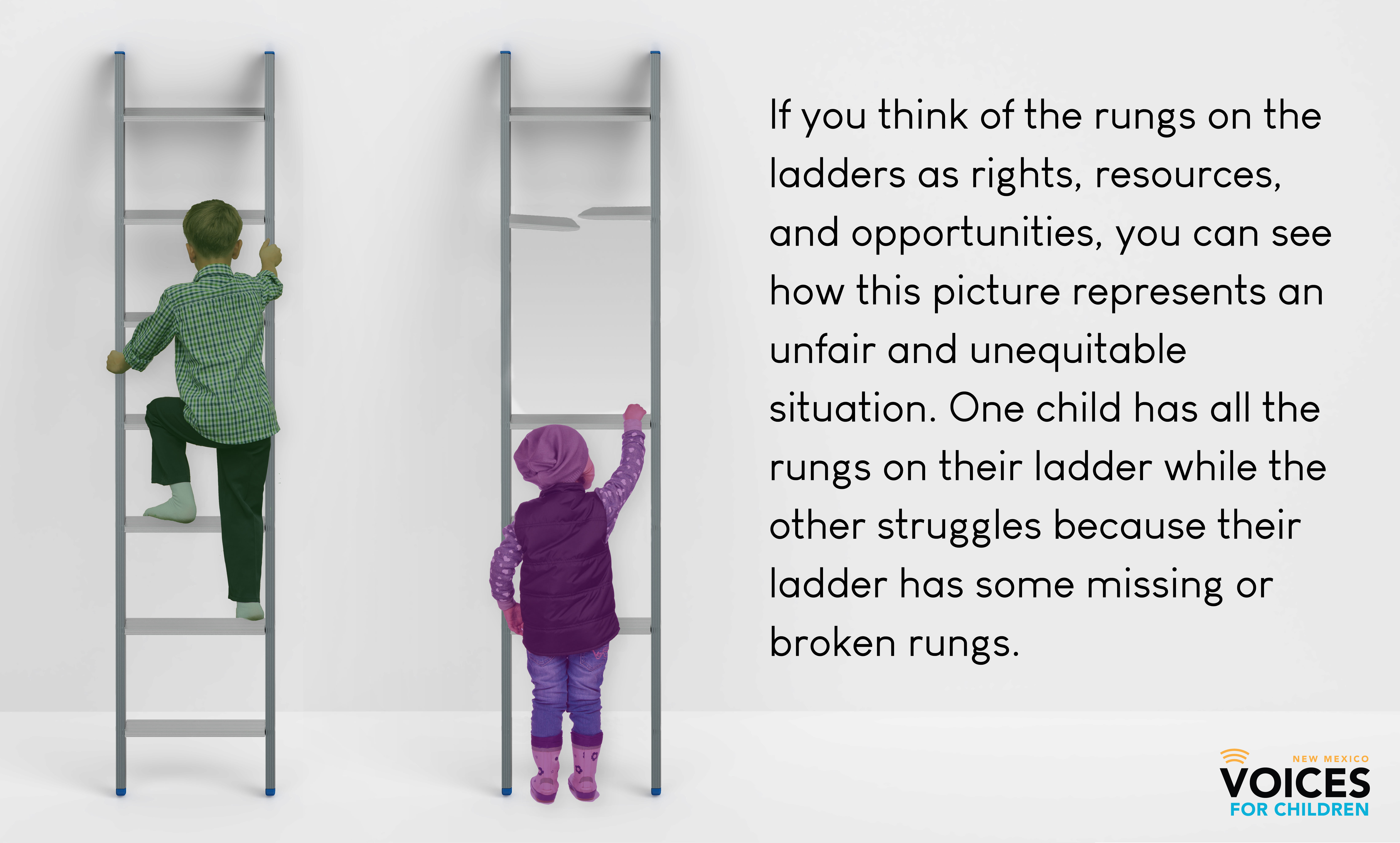Every child deserves to live in a society where they have an equal opportunity to participate, prosper, and reach their full potential in life – a society where neither race, ethnicity, class, sexuality, gender, disability, nor skin color can determine their opportunities and life outcomes. As much as we claim to value the idea of equity in America – and as much progress as we’ve made toward a more equitable society – we continue to keep policies in place that virtually ensure inequitable outcomes. Both nationally and in New Mexico children of color are much more likely than white children to be born into poverty, have poorer health outcomes, and have fewer opportunities for upward mobility.
To understand why this is, it helps to think of equity as the ladder we all climb to achieve our full potential. The rungs of the ladder are the rights, resources, and opportunities we all need to succeed – such as nutritious food, well-funded schools, safe housing, and community parks, libraries, and other infrastructure. Everyone’s ladder should have the same number of rungs – but they don’t. Children of color are far more likely than white children to live in communities where grocery stores and farmers markets are scarce, where schools are underfunded, and parks, libraries, and other infrastructure are either missing or in disrepair. The children on the ladders with missing rungs are going to struggle to reach their potential.

Just as public policies can result in inequity, they can also improve our children’s access to opportunities. In this series we examine public policies through an equity lens, beginning with some of the policies passed during the 2019 legislative session. Our aim is to highlight victories and discuss opportunities for public policy to increase equity, in areas like education, health care, state taxes and spending, and more. By making sure equity is at the core of new legislation, we can provide opportunities for all New Mexicans to prosper.
Equity, as defined for this series, is the absence of systems and practices that advantage some groups of people while disadvantaging others. One example of a public policy that promotes equity is Title IX, which requires that schools receiving federal funds offer sports activities for their female students that are commensurate with those offered for male students. Prior to Title IX, female athletes rarely were able to take advantage of the physical, psychological, and academic benefits of competitive and team sports. As much as Title IX did for female athletes, the struggle for equality in sports is far from over. For example, the U.S. Women’s Soccer team has had to resort to suing the U.S. Soccer Federation for paying its female players far less than its male players, despite the women’s team having a better record and drawing larger audiences.
Equity doesn’t just happen. It is a product of the systems and policies that work together to ensure (or not) that everyone has an opportunity to participate and thrive in our society. And just as equity doesn’t just happen, inequity – when people lack equal access to opportunities – is often rooted in a history of systemic oppression (including through colonization and slavery) that is perpetuated by public policies. Issues of equity aren’t just a concern for parents and families experiencing barriers in education, health care, and financial security – it concerns us all. When some New Mexicans are unable to thrive, we are unable as a society and community to reach our full potential. This is especially concerning in a state where people of color make up the majority of the population and 75 percent of our kids are children of color. Equity is the framework with which we can address the root causes of inequalities to undo harmful practices and policies thereby remedying social, political, cultural, and economic injustices.
There are many ways to address equity or to continue to perpetuate inequity in public policy. In this blog series, we began by focusing on the outcomes of the 2019 legislative session and how policy changes influenced equity.
Find our first blog, on tax policy, here
Find our second blog, on criminal and juvenile justice, here
Find our third blog, on college affordability, here
Find our fourth blog, on immigration, here
Find our fifth blog, on family economic security, here
Find our sixth blog, on education, here
2020 Advancing Equity blogs
Find our seventh blog, on the 2020 Census count, here
